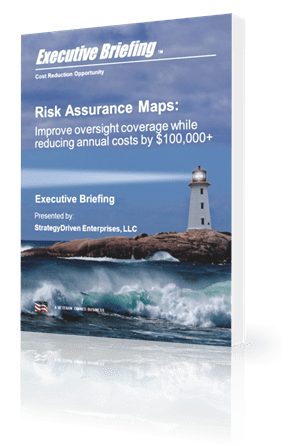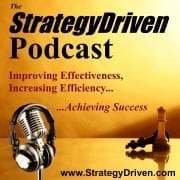StrategyDriven Editorial Perspective – Expanding Uncertainty in the U.S. Financial Sector, part 4

The ‘too big to fail’ philosophy found a home in the Dodd-Frank Wall Street Reform and Consumer Protection Act. This act provides the Federal Deposit Insurance Corporation (FDIC) with the power to seize and break up ‘too big to fail’ companies if it believes they are headed toward financial collapse.1 The FDIC’s authority covers non-financial corporations with at least $50 billion in assets as well as financial institutions. While this may sound like a reasonable solution to the ‘too big to fail’ problem, it only serves to make matters worse.
“One of the highest priorities is identifying the universe of non-bank financial companies that – because of their leverage; off-balance sheet exposures; nature, scope, size, scale, concentration, interconnectedness, and mix of activities; or other factors identified in the Dodd-Frank Act – should be subject to enhanced prudential supervision by the FRB.” 2
Sheila C. Bair
Chairman, Federal Deposit Insurance Corporation
on Systemically Important Institutions and the Issue of “Too Big to Fail” before the Financial Crisis Inquiry Commission
September 2, 2010
The ‘too big to fail’ provisions of the Dodd-Frank Wall Street Reform and Consumer Protection Act will not prevent companies systemically linked to the health of the U.S. economy from collapsing and in several ways promotes conditions that will exacerbate the next financial downturn. Consider:
- the Dodd-Frank Act does nothing to prevent companies from failing, it only prescribes a method for dealing with them once failure becomes eminent
- it places Washington bureaucrats in charge of dispositioning troubled companies; the same individuals who are often unable to balance the U.S. government’s budget, can’t tell citizens and businesses what the tax rates for 2011 will be three months in advance, and have compliance issues with respect to paying their personal income taxes
- by directing the dismantlement of large companies, fewer such large companies within the given sector will remain effectively increasing the impact their future collapse will have on the nation’s economy should such a collapse occur
- by providing a government supported collapse mechanism the financial risk associated with large companies is reduced which in turn will help them secure lower interest rates on borrowed funds and encourage further risk taking3
While the Dodd-Frank Wall Street Reform and Consumer Protection Act seeks to minimize the impact of the collapse of a ‘too big to fail’ company on the U.S. economy, it’s mechanism of corporate dismantlement and risk removal leaves the door open to even more impactful collapses in the future. As such, the solution provided addresses only half the issue. What the act missed is the prevention of a systemically linked company’s collapse to being with or, dare we suggest, the elimination of ‘too big to fail’ companies all together in a non-crisis setting.
StrategyDriven Recommended Practices
The significant marketplace uncertainty created by the Dodd-Frank Act will not likely be resolved soon; necessitating that company leaders act to mitigate, transfer, or eliminate these risks facing their organizations. In this specific case, StrategyDriven suggests company leaders consider the following:
- Follow the FDIC’s ‘too big to fail’ rule making process and understand how these new regulations will impact the operations of your firm’s ‘too big to fail’ partners, suppliers, and customers.
- Evaluate the financial position of those ‘too big to fail’ companies providing resources or services to your organization and the impact of an FDIC takeover on continued operations; implementing compensatory measures as appropriate
- Assess the financial position of those ‘too big to fail’ companies that are your clients and the potential impact an FDIC takeover would have on the demand for your products and/or services; implementing compensatory measures as appropriate
- Analyze your company’s overall supplier and customer portfolio and ensure the risks associated with ‘too big to fail’ companies previously identified are mitigated to an appropriate extent through the use of portfolio balancing
Final Thought…
The somewhat ill-conceived ‘too big to fail’ provisions of the Dodd-Frank Act serve as a lesson in problem resolution. As noted earlier, the Dodd-Frank Act does nothing to mitigate, transfer, or alleviate the problem of ‘too big to fail’ companies actually succumbing to financial collapse thereby doing nothing to prevent the initiating event of the Financial Crisis of 2008. Additionally, provisions of the act create circumstances that may make it more likely for a financial collapse to occur in the future, one with even greater impact. Remember that to effectively resolve any issue it is important to first define the problem and its causes and then to define and select a solution set that fully addresses the defined problem and its causes. Additional information on sound decision-making practices can be found in StrategyDriven’s Decision-Making topic area.
In an upcoming edition of the StrategyDriven Editorial Perspective, we’ll look at the potential impacts of the provisions of the Dodd-Frank Wall Street Reform and Consumer Protection Act that could present a proportionately larger burden on small companies.
As always, we’ll provide our thoughts on how business leaders can best prepare for the implementation of the financial reform law and weather the storm in the long-term. We also hope you’ll share your thoughts, lessons learned, and recommended resources with us and the StrategyDriven audience.
Final Request…
The strength in our community grows with the additional insights brought by our expanding member base. Please consider rating us and sharing your perspectives regarding the StrategyDriven Editorial Perspective podcast on iTunes by clicking here. Sharing your thoughts improves our ranking and helps us attract new listeners which, in turn, helps us grow our community.
Thank you again for listening to the StrategyDriven Editorial Perspective podcast!
Sources
- “FDIC puts breaks on ‘too big to fail’ reforms,” Los Angeles Times, October 3, 2010
- “Statement of Sheila C. Bair, Chairman, Federal Deposit Insurance Corporation on Systemically Important Institutions and the Issue of “Too Big to Fail” before the Financial Crisis Inquiry Commission,” Sheila C. Bair, Federal Deposit Insurance Corporation, September 2, 2010 (http://fdic.gov/news/news/speeches/chairman/spsep0210.html)
- “What Does ‘Too Big to Fail’ Really Cost?” Alain Sherter, BNET, March 29, 2010 (http://www.bnet.com/blog/financial-business/what-does-8220too-big-to-fail-8221-really-cost/4486?tag=content;drawer-container)
Podcast: Play in new window | Download (Duration: 8:59 — 12.4MB)
Subscribe: Apple Podcasts | RSS










Leave a Reply
Want to join the discussion?Feel free to contribute!